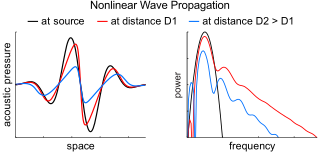Physical mechanism of thread breakup

The breakup process in a fluid thread or jet begins with the development of small perturbations on the free surface of the fluid. This is known as the linear theory of fluid thread breakup. These perturbations are always present and can be generated by numerous sources including vibrations of the fluid container or non-uniformity in the shear stress on the free surface. In general, these disturbances take an arbitrary form and are thus difficult to consider rigorously. It is therefore helpful to take a Fourier transform of the disturbances to decompose the arbitrary disturbances into perturbations of various single wavelengths on the surface of the thread. In doing so, this allows one to determine which wavelengths of the disturbance will grow and which will decay in time. [14]
The growth and decay of wavelengths can be determined by examining the change in pressure a perturbation wavelength imposes on the interior of the fluid thread. Changes to the internal pressure of the thread are induced by capillary pressure as the free surface of the thread deforms. Capillary pressure is a function of the mean curvature of the interface at a given location at the surface, meaning the pressure is dependent on the two radii of curvature that give the shape of the surface. Within the thinned area of a fluid thread undergoing breakup, the first radius of curvature is smaller than the radius of curvature in the thickened area, leading to a pressure gradient that would tend to force liquid from the thinned to thickened areas. However, the second radius of curvature remains important to the breakup process. For some perturbation wavelengths, the effect of the second radius of curvature can overcome the pressure effect of the first radius of curvature, inducing a larger pressure in the thickened regions than the thinned regions. This would push fluid back toward the thinned regions and tend to return the thread to its original, undisturbed shape. However, for other perturbation wavelengths, the capillary pressure induced by the second radius of curvature will reinforce that of the first radius of curvature. This will drive fluid from the thinned to the thickened regions and further promote thread breakup.

The wavelength of the perturbation is therefore the critical parameter in determining whether a given fluid thread will breakup into smaller masses of fluid. Rigorous mathematical examination of the perturbation wavelengths can lead to a relation showing which wavelengths are stable for a given thread as well as which perturbation wavelengths will grow most rapidly. The size of the fluid masses resulting from the breakup of a fluid thread can be approximated by the wavelengths of the perturbation that grow most rapidly.
Non-linear behavior
While linear theory is useful in considering the growth of small disturbances on the free surface, when the disturbances grow to have a significant amplitude, non-linear effects begin to dominate breakup behavior. The non-linear behavior of the thread governs its final breakup and ultimately determines the final shape and number of the resulting fluid masses.
Nonlinearity is captured through the use of self-similarity. Self-similarity assumes that the behavior of the fluid thread as the radius approaches zero is the same as the behavior of the fluid thread when it has some finite radius. Detailed understanding of non-linear thread behavior requires the use of asymptotic expansions to generate the appropriate scaling behavior. Numerous solutions have been found for the non-linear behavior of fluid threads based on the forces that are relevant in particular circumstances. [15] [16] [17]
Important parameters
How a fluid thread or jet undergoes breakup is governed by several parameters among which are the Reynolds number, the Weber number, Ohnesorge number, and the disturbance wavelength. While these numbers are common in fluid mechanics, the parameters selected as scales must be appropriate to thread breakup. The length scale most often selected is the radius of the fluid thread, while the velocity is most often taken to be the velocity of the bulk fluid motion. However, these scales can change based on the characteristics of the considered problem.
The Reynolds number is the ratio between inertia and viscous effects within the thread. For large Reynolds numbers, the effects of motion of the thread are much greater than viscous dissipation. Viscosity only has a minimal damping effect on the thread. For small Reynolds numbers, viscous dissipation is large and any disturbances are rapidly damped from the thread.
The Weber number is the ratio between inertia and surface tension effects within the thread. When the Weber number is large, the inertia of the thread is large which resists the tendency of surface tension to flatten bent surfaces. For small Weber numbers, the changes in the capillary pressure due to the surface disturbances is large and surface tension dominates thread behavior.
The Ohnesorge number is the ratio between viscous and surface tension effects within the thread. As it eliminates the effects of inertia and the need for a velocity scale, it is oftentimes more convenient to express scaling relationships in terms of the Ohnesorge number rather than the Reynolds and Weber number individually.
The perturbation wavelength is the characteristic length of the disturbance on the surface of the jet, assuming that any arbitrary disturbance can be decomposed via a Fourier transform into its constitutive components. The wavelength of the perturbation is critical in determining if a particular disturbance will grow or decay in time.























